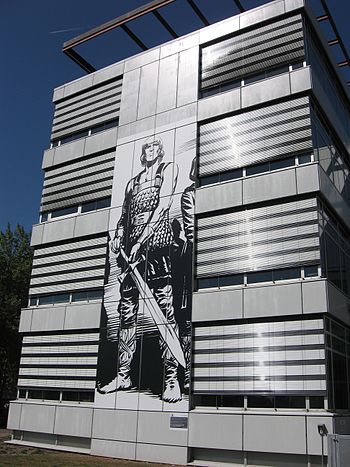Eric de Noorman
| Eric de Noorman | |
|---|---|

Eric de Noorman drawn on a building wall in Arnhem, Netherlands
|
|
| Author(s) | Hans G. Kresse |
| Current status / schedule | Discontinued |
| Launch date | July 5, 1946 |
| End date | January 24, 1964 |
| Syndicate(s) | Panda, Antoninus Pius |
| Genre(s) | Historical comics, Action, adventure |
Eric de Noorman ("Eric the Norseman") was a Dutch comic strip, published in text comic format, and drawn by Hans G. Kresse from 1946 until 1964. The stories featured a Viking king, Eric, and his adventures overseas. Together with Kapitein Rob and Tom Poes Eric de Noorman is widely considered to belong to the Big Three in Dutch comics history. Kresse's well documented stories and high quality drawing are still praised and influenced many other European comics artists. Eric de Noorman is also one of the few Dutch comics to be popular in foreign translations too. In the Netherlands it was published in Het Vaderland, De Nieuwe Haarlemsche Courant and Tom Poes Weekblad, in Flanders in Het Laatste Nieuws and De Nieuwe Gazet, in Wallonia in Le Soir and apart from French, it was also translated into Danish, Finnish, German, Spanish, Swedish, Portuguese and English. From 1948 on the stories were published in oblong format books at the low price of 75 cent.
Eric de Noorman is set during a vague Viking Age. Eric is a young Norse Viking king who lives together with his wife, Winonah, and son Erwin. Pum-Pum, a midget servant, is his trusty aid and advisor. He often travels abroad which brings him into all kinds of fights and adventures. In the earliest stories Eric is both seen in the Roman Empire as well as the Dark Ages of the Middle Ages. In one story he fights against Roman Emperor Commodus (177-192) in the arena. Afterwards he returns to Norway, where he is in the presence of noblemen living in castles in fashions that are more reminiscent of the 12th and 13th centuries. Apart from these anachronisms, Kresse also used a lot of fantasy elements, such as Norse mythology and the Isle of Atlantis. From the story De Witte Raaf ("The White Raven") on Kresse used more documentation which made the stories more historically accurate. He set the stories in a specific time period, namely the 5th century. This allowed Eric to meet historical and mythological characters such as the British king Vortigern (Vitalinus), King Arthur, Attila the Hun and Flavius Aetius. Apart from historical accuracy Kresse also drew real-life locations such as Hadrian's Wall, Stonehenge, the menhir field of Carnac and the Mousa Broch. The more magical elements disappeared from the series.
...
Wikipedia
